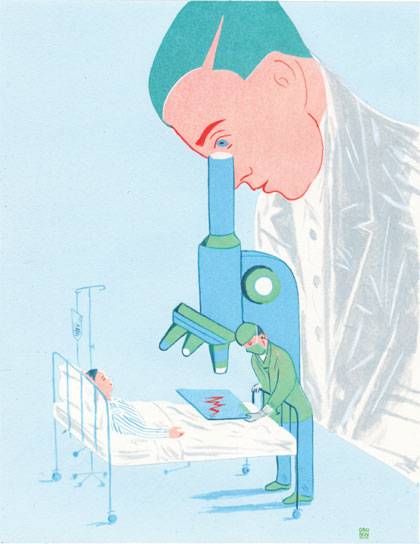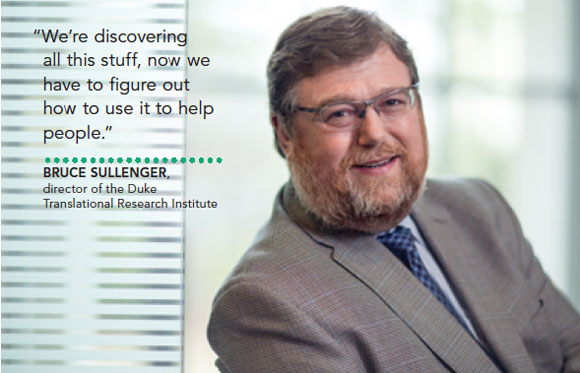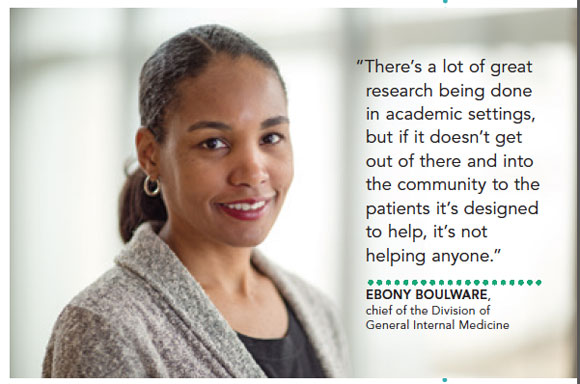
We know more about the human body today than we did yesterday, and tomorrow we’ll know even more—a lot more. In the last two decades, advances in human genome sequencing, molecular imaging, and other areas have sparked a research revolution that reveals ever more detailed and precise information about how our bodies work. Every day brings new discoveries, many of which may hold the potential to improve human health in meaningful ways.
But the pace at which those discoveries lead to improved health has been frustratingly slow. Yes, new drugs and new therapies do reach patients, and when they do, they often make a tremendous difference. But relative to the number of research projects conducted, papers published, and trials run, it is clear that new health care advances have lagged behind the vast amounts of data generated by the explosion in biomedical discovery.
Duke is playing a lead role among academic medical institutions working to change that. On multiple fronts, and in collaboration with partners within the university and nationwide, Duke researchers and clinicians are exploring ways to increase the speed and efficiency with which research discoveries are translated into advances in patient care.
Last October, the National Institutes of Health awarded the Duke Translational Medicine Institute a five-year, $47 million grant to help fuel that effort. The Clinical and Translational Science Award (CTSA) provides wide-ranging resources for clinical researchers at Duke and an infrastructure that supports sharing developments across a consortium of more than 60 other research institutions nationwide. The award represents a renewal of the grant that Duke received in the initial round of CTSA funding in 2006.
“Our vision is to create a research environment at Duke that links discovery science with a creative engine that can accelerate the development of new technologies based on scientific merit and societal need to improve public health,” says cardiologist Robert M. Califf, T’73, MD’78, HS’78, ’80-’83, the Donald F. Fortin, MD, Professor of Cardiology, director of the Duke Translational Medicine Institute and vice chancellor of clinical and translational research.
There are many challenges to closing the gap between new knowledge and new therapies, says Califf.
“If you look at drug development, the failure rate is over 95 percent,” he says. “So an enormous amount of money is being spent nationwide on things that don’t work. We have to get better at predicting what will be successful. There’s a huge irreproducibility problem; we need systems to better reconstruct data and, when things fail, to understand why they failed. On the clinical side, every year there’s more regulation, and it becomes harder and more expensive to do trials.”
The process of translating laboratory discovery into patient care—often referred to as a “bench to bedside” process—is more complex and more varied than it might first appear. At Duke, researchers are approaching translational research from various angles and coming up with innovative ways to overcome the many challenges.

TEAM SCIENCE: BENCH TO BEDSIDE
When Bruce Sullenger, PhD, began working to try to develop a new anticoagulant drug made with the ubiquitous molecule ribonucleic acid (RNA) to prevent dangerous blood clots in patients during cardiac or vascular surgery, he quickly learned that he was only addressing half the problem.
“Some of the cardiologists pointed out that the challenge wasn’t inhibiting blood clotting,” says Sullenger, the Joseph W. and Dorothy W. Beard Professor of Surgery and director of the Duke Translational Research Institute. “The challenge is that when you inhibit blood clotting you also create the safety risk of excess bleeding. It’s like one of those angry emails you send out and then wish you could pull back: you give a patient an anticoagulant, and then they start bleeding and you need to quickly pull it back. It’s a fine line.”
Using RNA’s innate capability to act as a sort of molecular switching mechanism, Sullenger managed to walk that line. He found a way to make both a novel blood thinner and its own antidote: a companion molecule that would bind to the first and very quickly produce the opposite effect.
Sullenger founded a company, Regado Biosciences, to raise the capital to continue development and trials of the new drug, called REG1. REG1 is currently in a phase 3 clinical trial of more than 13,000 patients, and the company went public last fall—one of four Duke biomedical spinoff companies to do so last year. In early March 2014 the Food and Drug Administration (FDA) designated REG1 as a “Fast Track” development program with the goal of making it available for use in patients sooner.
It’s a classic example of bench-to-bedside research—but the journey, like most similar ones, has been anything but fast and inexpensive. Sullenger began work on the project well over a decade ago. Data suggests that taking just one discovery from the lab to development and delivery to patients costs millions if not billions of dollars.
Among the things he has learned is that it takes a lot more than just scientists to shepherd a novel therapy along the translational path. You can’t just focus on molecules, physiology, and potential clinical applications. You also have to think—and this may not come naturally to a lot of scientists—about venture capital.
“The drug has worked as well as you could hope, but it’s taken longer than I would have thought, because you have to raise money,” says Sullenger. “There’s a whole business side of it. It costs so much money that you have to go outside the university. You need a critical mass of innovators and entrepreneurs to move these things forward. Translation is team science. It’s fundamentally different than being a scientist working alone in an ivory tower lab. Collaboration is critical.”
The Duke Translational Research Institute that Sullenger directs is designed to support and facilitate translational research. The institute, established with the initial CTSA grant, awards pilot grants and helps researchers move projects through the pipeline, identify potential funding sources, negotiate the regulatory maze, and tap the expertise and collaboration of project leaders in many fields.
That last part is one of the things Duke does best, Sullenger says.
“Duke is leading in the area of putting teams together,” he says. “We try to find the best people from the private sector who know the culture of pharma or business or biotech and bring them here. They come back to Duke because they believe in this mission: We’re discovering all this stuff, now we have to figure out how to use it to help people. A lot of other institutions are struggling with that. We’ve changed the culture that way, and it’s really helping us.”

RESEARCH THAT MAKES A DIFFERENCE: CLINICAL TRIALS
Newborn babies who develop potentially fatal intra-abdominal infections are often treated with an antibiotic called meropenem. Until recently, though, no one really knew what the most effective dose was for infants less than three months old, or even whether it was truly safe to treat them with the antibiotic: in adults, similar compounds have been linked to seizures.
Thanks to the Pediatric Trials Network (PTN), a $95 million National Institutes of Health initiative headed by Danny Benjamin, MD, PhD, MPH, HS’98-’01, professor of pediatrics and faculty director of trials at the Duke Clinical Research Institute, we now have answers to those questions. And we are gaining answers to similar questions about many other drugs used in children.
The NIH tapped Benjamin to lead the PTN, a nationwide initiative designed to close a critical loophole in drug regulations: the lack of pediatric dosing and safety standards for off-patent, or generic, drugs.
In the absence of such standards, pediatricians have to rely on their experience and expertise to prescribe these medications. Empirically tested and approved dosing guidelines would lead to safer, more consistent, and more efficient use of such drugs in children.
“Twenty years ago, in pediatrics we simply took the adult dose of a drug, divided by 70, and gave it on a milligram-per-kilogram basis,” Benjamin says. “Now that seems laughable. But it’s still the case with a lot of these off-patent drugs. We’re fixing that.”
Under Benjamin’s leadership, the PTN is in various stages of generating data to guide the pediatric use of more than two dozen drugs. In the case of meropenem, Duke’s Michael Cohen-Wolkowiez, MD, HS’09, associate professor of pediatrics, and P. Brian Smith, MD, MPH, MHS’06, HS’01-’07, associate professor of pediatrics, led a study of 200 young infants. Among the questions the investigators wanted to answer: What is the safest and most effective dose? Does the drug increase the risk of seizures or other serious side effects? And does it reach the brain?
“In babies, infections in the blood go to their brain,” says Benjamin. “If you use a molecule that’s only good in the blood but doesn’t reach the brain, you’re going to have a baby that might look better but really has that bug still in the brain, as meningitis. And you do not want that.”
The trial’s findings? Meropenem is safe to use in very young infants, some babies should get a higher dose than had been customarily prescribed, there is no statistical correlation between the drug and seizures, and, yes, it does work in the brain. The FDA is in the final stages of requiring re-labeling to reflect the findings.
“This will change the way people dose the molecule, and it changes the safety profile,” Benjamin says. “This is research that is going to make a difference.”

THE LAST MILE: COMMUNITY TRANSLATION
Translational research is generally considered a process that starts in the lab—the “bench”—where a new drug, device, or procedure is developed, and ends with the production that makes it available in the clinic—the “bedside.”
But for Ebony Boulware, MD’95, MPH, that ending point is where translational research begins.
“There’s translation from the bench to the bedside,” says Boulware, chief of the Division of General Internal Medicine. “What I do is take things from the bedside into the community.
“This is the last mile on the translational research spectrum,” she says. “Our ultimate goal in health care is for the things we learn in our research to be practically applied in communities in ways that matter to patients. That really is the last mile of the journey.”
It’s a particularly challenging step. The potential barriers between promising treatments and the people who could benefit from them, especially those in underserved populations, are legion. Bridging the last mile requires, among other things, access to services, effective communication between patients and health care workers, mutual trust, coordination of care, commitment by policy makers, and mechanisms to ensure sustainability over time.
Every one of those issues presents its own challenges, says Boulware.
“We have a lot of research showing various interventions to be in one way or another efficacious, meaning it works in an ideal research setting,” she says. “We have much less effectiveness research, meaning, ‘Does it work when you take it out of that ideal setting and into the real world?’”
Boulware, who earned her medical degree at Duke in 1995, returned to join the faculty in October 2013 from the Johns Hopkins University School of Medicine. In Baltimore, she conducted several studies of ways to improve the effectiveness of health care for patients, including a study exploring the real-world effectiveness of home blood pressure monitoring for African-American patients with hypertension. At Duke, she joins an institution that is one of two leading the Southeastern Diabetes Initiative, a $10 million Health Care Innovation program that collaborates with community partners to use geospatial mapping, electronic records, and a specially trained workforce to reduce death and disability from type-2 diabetes among at-risk populations.
Boulware says one lesson from effectiveness research stands out above all the others: the importance of ongoing community engagement in biomedical research. That engagement, she says, should start before research actually begins and continue after it is complete.
“Communities are familiar with researchers coming and gathering people up for studies and then saying, ‘OK, thanks very much, we have our results and we’ll go ahead and publish those,’ and then the researchers are gone. We need to engage with communities throughout the research process, from identifying health care needs to participating in the research and then in the dissemination of research findings. Thinking about research this way takes the focus away from just the researchers and shifts it more toward a partnership with communities.”